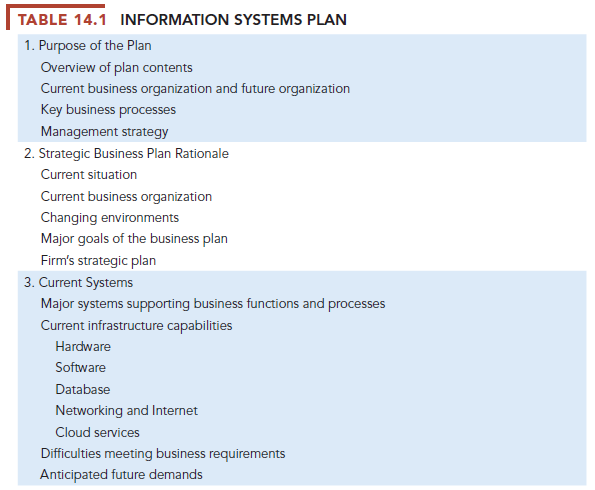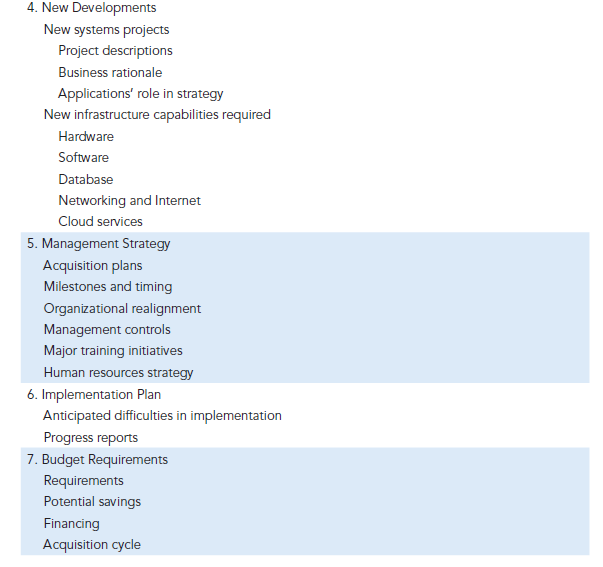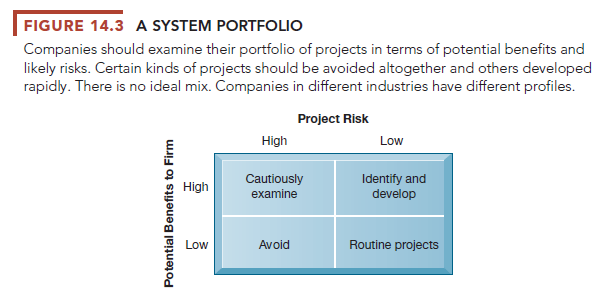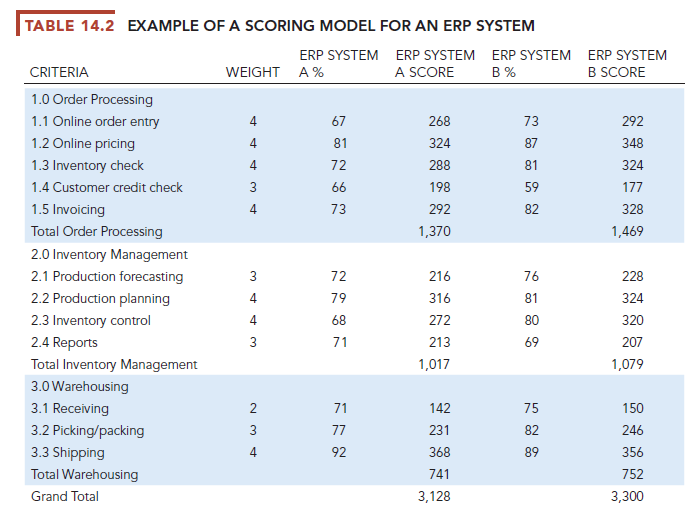Companies typically are presented with many different projects for solving problems and improving performance. There are far more ideas for systems projects than there are resources. Firms will need to select the projects that promise the greatest benefit to the business. Obviously, the firm’s overall business strategy should drive project selection. How should managers choose among all the options?
1. Management Structure for Information Systems Projects
Figure 14.2 shows the elements of a management structure for information systems projects in a large corporation. It helps ensure that the most important projects are given priority.
At the apex of this structure is the corporate strategic planning group and the information systems steering committee. The corporate strategic planning group is responsible for developing the firm’s strategic plan, which may require the development of new systems. Often, this group will have developed objective measures of firm performance (called key performance indicators, introduced in Chapter 2 and Chapter 12) and choose to support IT projects that can make a substantial improvement in one or several key performance indicators. These performance indicators are reviewed and discussed by the firm’s board of directors.

The information systems steering committee is the senior management group with responsibility for systems development and operation. It is composed of department heads from both end-user and information systems areas. The steering committee reviews and approves plans for systems in all divisions, seeks to coordinate and integrate systems, and occasionally becomes involved in selecting specific information systems projects. This group also has a keen awareness of the key performance indicators decided on by higher-level managers and the board of directors.
The project team is supervised by a project management group composed of information systems managers and end-user managers responsible for overseeing specific information systems projects. The project team is directly responsible for an individual systems project. It consists of systems analysts, specialists from the relevant end-user business areas, application programmers, and perhaps database specialists. The mix of skills and the size of the project team depend on the specific nature of the system solution.
2. Linking Systems Projects to the Business Plan
In order to identify the information systems projects that will deliver the most business value, organizations need to develop an information systems plan that supports their overall business plan and in which strategic systems are incorporated into top-level planning. The plan serves as a road map indicating the direction of systems development (the purpose of the plan), the rationale, the state of current systems, new developments to consider, the management strategy, the implementation plan, and the budget (see Table 14.1).


The plan contains a statement of corporate goals and specifies how information technology will support the attainment of those goals. The report shows how general goals will be achieved by specific systems projects. It identifies specific target dates and milestones that can be used later to evaluate the plan’s progress in terms of how many objectives were actually attained in the time frame specified in the plan. The plan indicates the key management decisions, technology, and required organizational change.
In order to plan effectively, firms will need to inventory and document all of their information system applications, IT infrastructure components, and long- and short-term information requirements. For projects in which benefits involve improved decision making, managers should try to identify the decision improvements that would provide the greatest additional value to the firm. They should then develop a set of metrics to quantify the value of more timely and precise information on the outcome of the decision. (See Chapter 12 for more detail on this topic.)
2. Portfolio Analysis
Once strategic analyses have determined the overall direction of systems development, portfolio analysis can be used to evaluate alternative systems projects. Portfolio analysis inventories all of the organization’s information systems projects and assets, including infrastructure, outsourcing contracts, and licenses. This portfolio of information systems investments can be described as having a certain profile of risk and benefit to the firm (see Figure 14.3) similar to a financial portfolio.
Each information systems project carries its own set of risks and benefits. (Section 14-4 describes the factors that increase the risks of systems projects.) Firms would try to improve the return on their portfolios of IT assets by balancing the risk and return from their systems investments. Although there is no ideal profile for all firms, information-intensive industries (e.g., finance) should have a few high-risk, high-benefit projects to ensure that they stay current with technology. Firms in non-information-intensive industries should focus on high-benefit, low-risk projects.
Most desirable, of course, are systems with high benefit and low risk. These promise early returns and low risks. Second, high-benefit, high-risk systems should be examined; low-benefit, high-risk systems should be totally avoided; and low-benefit, low-risk systems should be reexamined for the possibility of rebuilding and replacing them with more desirable systems having higher benefits. By using portfolio analysis, management can determine the optimal mix of investment risk and reward for their firms, balancing riskier high-reward projects with safer lower-reward ones. Firms where portfolio analysis is aligned with business strategy have been found to have a superior return on their IT assets, better alignment of IT investments with business objectives, and better organization-wide coordination of IT investments (Jeffrey and Leliveld, 2004).

3. Scoring Models
A scoring model is useful for selecting projects where many criteria must be considered. It assigns weights to various features of a system and then calculates the weighted totals. Using Table 14.2, the firm must decide among two alternative enterprise resource planning (ERP) systems. The first column lists the criteria that decision makers will use to evaluate the systems. These criteria are usually the result of lengthy discussions among the decision-making group. Often the most important outcome of a scoring model is not the score but agreement on the criteria used to judge a system.
Table 14.2 shows that this particular company attaches the most importance to capabilities for sales order processing, inventory management, and warehousing. The second column in Table 14.2 lists the weights that decision makers attached to the decision criteria. Columns 3 and 5 show the percentage of requirements for each function that each alternative ERP system can provide. Each vendor’s score can be calculated by multiplying the percentage of requirements met for each function by the weight attached to that function. ERP System B has the highest total score.

As with all “objective” techniques, there are many qualitative judgments involved in using the scoring model. This model requires experts who understand the issues and the technology. It is appropriate to cycle through the scoring model several times, changing the criteria and weights, to see how sensitive the outcome is to reasonable changes in criteria. Scoring models are used most commonly to confirm, to rationalize, and to support decisions rather than as the final arbiters of system selection.
Source: Laudon Kenneth C., Laudon Jane Price (2020), Management Information Systems: Managing the Digital Firm, Pearson; 16th edition.

21 Jun 2021
21 Jun 2021
21 Jun 2021
21 Jun 2021
21 Jun 2021
21 Jun 2021